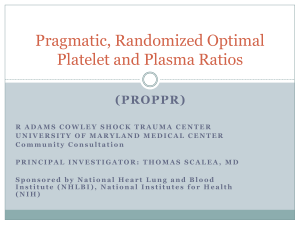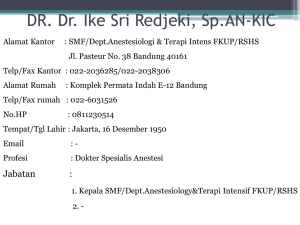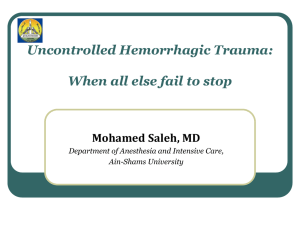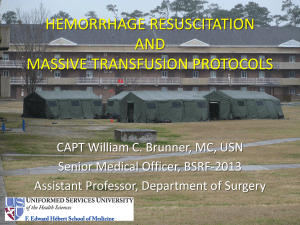134_2013_2906_MOESM20_ESM
advertisement
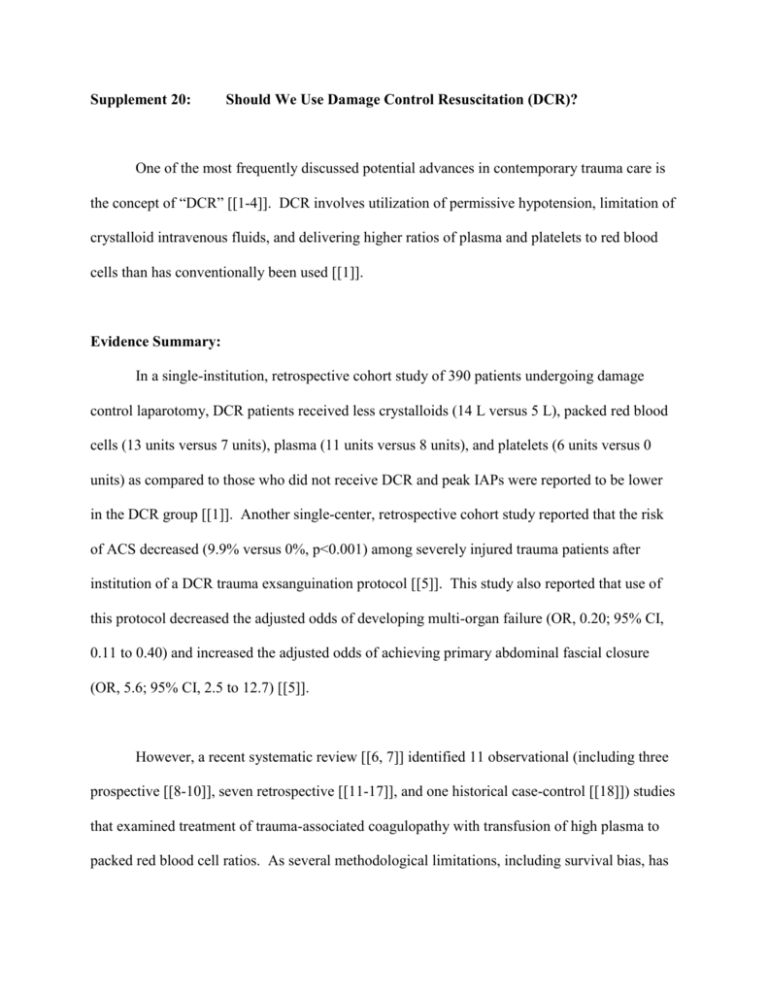
Supplement 20: Should We Use Damage Control Resuscitation (DCR)? One of the most frequently discussed potential advances in contemporary trauma care is the concept of “DCR” [[1-4]]. DCR involves utilization of permissive hypotension, limitation of crystalloid intravenous fluids, and delivering higher ratios of plasma and platelets to red blood cells than has conventionally been used [[1]]. Evidence Summary: In a single-institution, retrospective cohort study of 390 patients undergoing damage control laparotomy, DCR patients received less crystalloids (14 L versus 5 L), packed red blood cells (13 units versus 7 units), plasma (11 units versus 8 units), and platelets (6 units versus 0 units) as compared to those who did not receive DCR and peak IAPs were reported to be lower in the DCR group [[1]]. Another single-center, retrospective cohort study reported that the risk of ACS decreased (9.9% versus 0%, p<0.001) among severely injured trauma patients after institution of a DCR trauma exsanguination protocol [[5]]. This study also reported that use of this protocol decreased the adjusted odds of developing multi-organ failure (OR, 0.20; 95% CI, 0.11 to 0.40) and increased the adjusted odds of achieving primary abdominal fascial closure (OR, 5.6; 95% CI, 2.5 to 12.7) [[5]]. However, a recent systematic review [[6, 7]] identified 11 observational (including three prospective [[8-10]], seven retrospective [[11-17]], and one historical case-control [[18]]) studies that examined treatment of trauma-associated coagulopathy with transfusion of high plasma to packed red blood cell ratios. As several methodological limitations, including survival bias, has limited the examination of the effect of DCR on mortality, this systematic review concluded that insufficient evidence existed to support a survival advantage with DCR. A summary of Studies Table is available online at Supplement A9 - Summary of Studies for Damage Control Resuscitation. Reccomendation: The WSACS SUGGESTS that an enhanced ratio of plasma/packed red blood cells should be used for resuscitation of massive hemorrhage versus low or no attention to plasma/packed red blood cell ratios (Management suggestion 5; GRADE 2D). Rationale: Although DCR may avoid crystalloid over-resuscitation and possibly IAH/ACS, its impact on many patient-important outcomes remains unknown. References 1. 2. 3. Cotton BA, Reddy N, Hatch QM, LeFebvre E, Wade CE, Kozar RA, Gill BS, Albarado R, McNutt MK, Holcomb JB, (2011) Damage control resuscitation is associated with a reduction in resuscitation volumes and improvement in survival in 390 damage control laparotomy patients. Annals of surgery 254: 598-605 Holcomb JB, Jenkins D, Rhee P, Johannigman J, Mahoney P, Mehta S, Cox ED, Gehrke MJ, Beilman GJ, Schreiber M, Flaherty SF, Grathwohl KW, Spinella PC, Perkins JG, Beekley AC, McMullin NR, Park MS, Gonzalez EA, Wade CE, Dubick MA, Schwab CW, Moore FA, Champion HR, Hoyt DB, Hess JR, (2007) Damage control resuscitation: directly addressing the early coagulopathy of trauma. J Trauma 62: 307-310 Beekley AC, (2008) Damage control resuscitation: a sensible approach to the exsanguinating surgical patient. Critical care medicine 36: S267-274 4. 5. 6. 7. 8. 9. 10. 11. 12. 13. 14. 15. 16. 17. 18. Duchesne JC, Barbeau JM, Islam TM, Wahl G, Greiffenstein P, McSwain NE, Jr., (2011) Damage control resuscitation: from emergency department to the operating room. The American surgeon 77: 201-206 Cotton BA, Au BK, Nunez TC, Gunter OL, Robertson AM, Young PP, (2009) Predefined massive transfusion protocols are associated with a reduction in organ failure and postinjury complications. J Trauma 66: 41-48; discussion 48-49 Rajasekhar A, Gowing R, Zarychanski R, Arnold DM, Lim W, Crowther MA, Lottenberg R, (2011) Survival of trauma patients after massive red blood cell transfusion using a high or low red blood cell to plasma transfusion ratio. Critical care medicine 39: 1507-1513 Balogh ZJ, (2011) Traumatic shock resuscitation with a 1:1 plasma to packed red blood cell ratio: is it to please ourselves or the injured? Critical care medicine 39: 1597-1598 Scalea TM, Bochicchio KM, Lumpkins K, Hess JR, Dutton R, Pyle A, Bochicchio GV, (2008) Early aggressive use of fresh frozen plasma does not improve outcome in critically injured trauma patients. Annals of surgery 248: 578-584 Sperry JL, Ochoa JB, Gunn SR, Alarcon LH, Minei JP, Cuschieri J, Rosengart MR, Maier RV, Billiar TR, Peitzman AB, Moore EE, (2008) An FFP:PRBC transfusion ratio >/=1:1.5 is associated with a lower risk of mortality after massive transfusion. The Journal of trauma 65: 986-993 Shaz BH, Dente CJ, Nicholas J, MacLeod JB, Young AN, Easley K, Ling Q, Harris RS, Hillyer CD, (2010) Increased number of coagulation products in relationship to red blood cell products transfused improves mortality in trauma patients. Transfusion 50: 493-500 Borgman MA, Spinella PC, Perkins JG, Grathwhol KW, Repine T, Beekley AC, Sebesta J, Jenkins D, Wade CE, Holcomb JB, (2007) The ratio of blood products transfused affects mortality in patients receiving massive transfusions at a combat support hospital. J Trauma 63: 805-813 Duchesne JC, Hunt JP, Wahl G, Marr AB, Wang YZ, Weintraub SE, Wright MJ, McSwain NE, Jr., (2008) Review of current blood transfusions strategies in a mature level I trauma center: were we wrong for the last 60 years? The Journal of trauma 65: 272-276; discussion 276-278 Kashuk JL, Moore EE, Johnson JL, Haenel J, Wilson M, Moore JB, Cothren CC, Biffl WL, Banerjee A, Sauaia A, (2008) Postinjury life threatening coagulopathy: is 1:1 fresh frozen plasma:packed red blood cells the answer? The Journal of trauma 65: 261-270; discussion 270-261 Maegele M, Lefering R, Paffrath T, Tjardes T, Simanski C, Bouillon B, (2008) Red-blood-cell to plasma ratios transfused during massive transfusion are associated with mortality in severe multiple injury: a retrospective analysis from the Trauma Registry of the Deutsche Gesellschaft fur Unfallchirurgie. Vox Sang 95: 112-119 Snyder CW, Weinberg JA, McGwin G, Jr., Melton SM, George RL, Reiff DA, Cross JM, HubbardBrown J, Rue LW, 3rd, Kerby JD, (2009) The relationship of blood product ratio to mortality: survival benefit or survival bias? J Trauma 66: 358-362; discussion 362-354 Teixeira PG, Inaba K, Shulman I, Salim A, Demetriades D, Brown C, Browder T, Green D, Rhee P, (2009) Impact of plasma transfusion in massively transfused trauma patients. The Journal of trauma 66: 693-697 Zink KA, Sambasivan CN, Holcomb JB, Chisholm G, Schreiber MA, (2009) A high ratio of plasma and platelets to packed red blood cells in the first 6 hours of massive transfusion improves outcomes in a large multicenter study. American journal of surgery 197: 565-570; discussion 570 Gunter OL, Jr., Au BK, Isbell JM, Mowery NT, Young PP, Cotton BA, (2008) Optimizing outcomes in damage control resuscitation: identifying blood product ratios associated with improved survival. The Journal of trauma 65: 527-534

